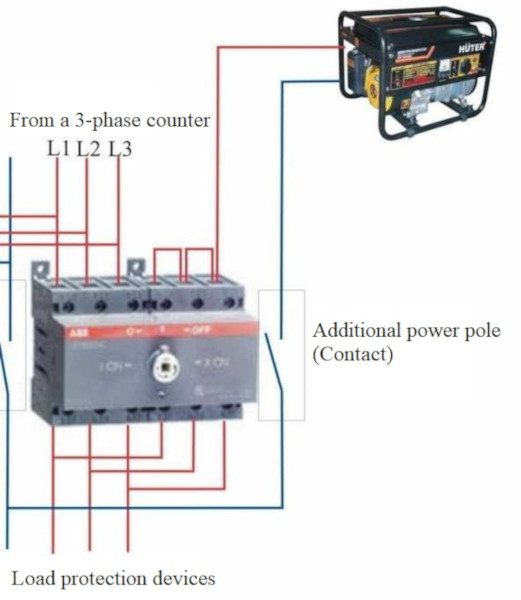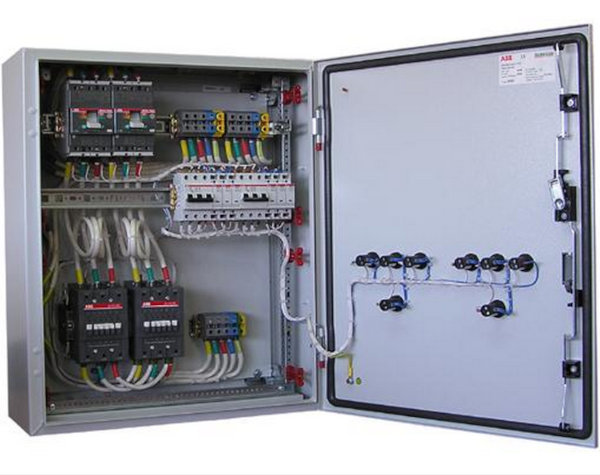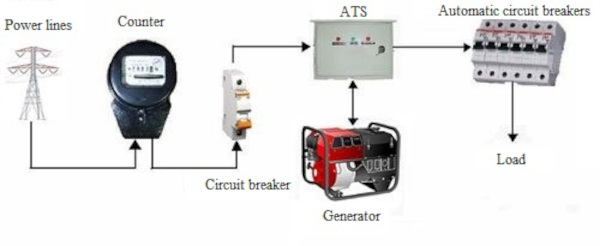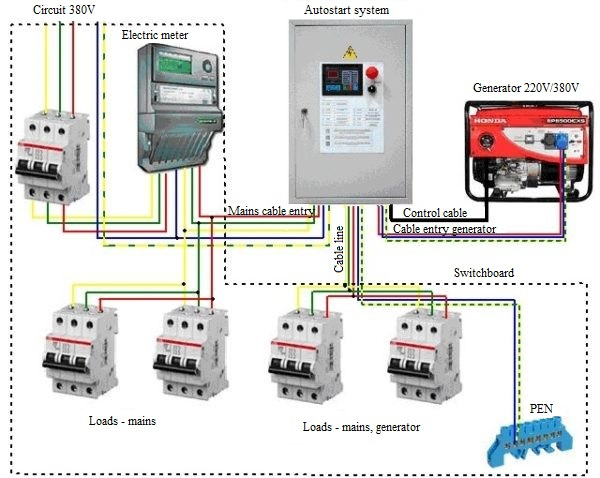The use of an electric power generator in the house can be done in 2 ways: by connecting electrical appliances directly to the outlet of the unit through an extension cord and by integrating the generator into the general electrical network of the room. If the first method is suitable for infrequent and short-term use (for example, in the country or nature), then the second method is used for prolonged power outages or in its complete absence at the facility. In this article, we will talk about generators as the main or backup power source in a country house or any other building (in a store, workshop, or production facilities) and about their correct connection.
Tasks to complete
Before connecting the power plant to the house network, you need to solve several tasks:
- Understand how much backup power is needed. To assess how critical a power outage will be or if constant power is required (for example, if a server is running in the house or just expensive equipment)
- Determine the location for the unit, taking into account safe operation and close distance to the connection point.
- Calculate the required power for all electrical appliances in the house that can be used. It is also necessary to take into account possible losses on the line and leave a small power reserve (20-30%).
- Decide on the choice of using automation or manual control.
- The use of automatic control and protection systems will be more expensive due to the cost and the need for additional measures to protect the wiring from strong voltage surges when switching from the common network to the generator and vice versa. A more gentle measure would be to use manual control when you make the switch yourself.
When the generator is connected, work is performed with 3 networks:
- the common network through which the house receives electricity;
- the internal network of the house;
- wiring of the generator.
Why it is impossible make the generator connection through an outlet
Connecting via a connector is a fairly simple procedure, but you should not give preference to it when connecting the generator to the general household power grid, as this entails many problems:
- The possibility of overload at the connection point – since the entire load falls completely on only one outlet, this is fraught with rapid overheating, melting and even its ignition.
- The absence of a separate automatic machine in the electrical line, which would be responsible for safety and emergency shutdown in case of dangerous situations.
- Inattention of a person – when turning on the unit, they sometimes forget to turn off the input machine. This entails overload and activation of the protection unit
- The possibility of generator failure when starting the electric current along the line and its contact with the contacts of the working unit. In this case, serious repairs or complete replacement of the power plant may be required.
Ways to connect the generator to the network
There are 3 ways to properly connect the power plant to the house network.
Flip (reversible) switch (manual control)
This is the device that will be responsible for the secure connection. Advantages of this type of management:
- Simplicity of design – the switch is equipped with 3 modes – 1-0-2. 1 – power from the common network, 0 – closing off all contacts, 2 – power from the generator.
- Easy connection – a common network is connected to the upper part of the switch on the left side, and a generator is connected to the right side. From below, jumper wires form the input to the general house line. For the safety of the system, it is recommended to add automatic machines to each line. They ensure that the system is shut down during overloads and other critical situations.
- Affordable price – switches of this type cost 5-10 EUR.
Starting the generator with a flip switch:
- disconnect the input machine,
- the switch is set to position 2,
- switch off the load automaton,
- starting the generator (the unit is warmed up before full operation for 4 minutes),
- current is applied to the switch,
- switch on the load automaton.
Grounding of the generator in this case is mandatory. For these purposes, a metal rod with a length of 2 m is hammered into the ground and connected through a copper wire to the corresponding terminal on the generator.
This option is also used to connect a single-phase generator to a three-phase network. The diagram below shows how to properly connect the unit to the electrical line.

Semi-automatic AVR unit (automatic reserve input) on contactors
- In this case, the simplest version of the AVR block with priority to the backbone network is used.
- For a shared system, you will need:
- AVR machines based on semiconductors (2 pcs.), which are interconnected;
- Cable with a cross-section of at least 4 mm2. The length of the cable is determined by the distance of the structure from the generator;
- Automatic machines that disconnect lines;
- Metal box – the dimensions depend on the dimensions of the installed electrical equipment and the installation location.

Connection scheme:
- All elements of the system are assembled in the box: automatic machines are installed, and AVR units are connected to them, after which the correct connection is checked.
- The connection of the circuit elements is clearly shown in the scheme:

3. Grounding of the generator.
Starting the system:
• If there is no power supply in the general network, the generator starts and the line will automatically switch due to the contactor closure.
• When a current appears in the general network, switching from the generator to the centralized power supply will occur automatically. At the same time, you should only turn off the generator for the sake of saving fuel.
For the convenience of controlling and protecting the system, you can additionally install a relay that will turn off the unit when the common network is activated, and turn it on with a delay of 4 minutes so that the generator has time to warm up.
Automatic control unit connection
This type of connection is considered the best for today. The detailed connection diagram is shown in the picture below.

For this type of connection, it is necessary to select a generator with autorun to build a fully automated system. And to avoid problems with frequent refilling of fuel, you can additionally purchase a large gas tank.
The principle of operation of the system:
- When the current supply in the general network is stopped, the unit quickly reacts to changes and triggers an AVR signal, which, in turn, activates the generator. After starting, the unit is given 4 minutes to warm up, after which electricity enters the general house network.
- After the resumption of the current supply from the common main line, the generator automatically turns off.
Basic rules for connection of the generator in the house
Compliance with these rules will avoid dangerous situations and equipment failure.
- Before connecting the gasoline generator to the mains, ensure good ventilation in the room where it will be installed. This is especially true for air-cooled models;
- The room must be heated and protected from dampness and moisture;
- Do not place the unit near heating appliances and other heat sources, including direct sunlight;
- Before refueling, the generator should be turned off;
- If you have spilled fuel near a power plant, wipe it thoroughly;
- After connecting the contacts, no bare wires should remain;
- Be sure to ground the unit during installation;
- During the operation of the generator, observe safety precautions: do not approach the unit in clothes with loose hanging edges, with loose hair, as the fan can pull them inside;
- Before each switching on of the generator, it is necessary to check the serviceability of all mechanisms and components of the system, and if a malfunction is detected, repair or replace the spent elements promptly.

There are no comments yet.